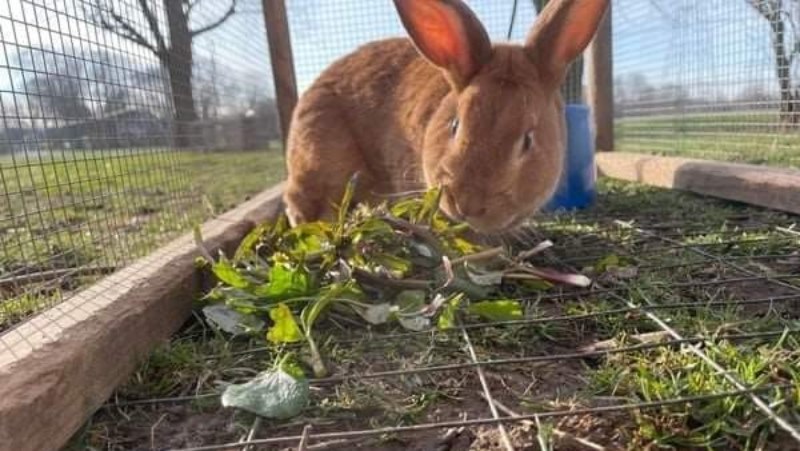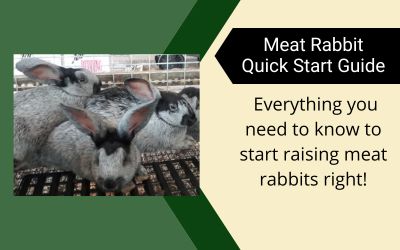
(Guest post by Jarri Lavone of Indiana)
“Have you seen the price of meat lately??” Many people are saying this. Maybe you too. And it’s causing people to consider growing their own meat. Meat that you grow is fresher, tastier, humanely raised, and has no preservatives added.
The first meat most people think about raising is chicken. True, the Cornish Cross meat chickens grow fast (about 8 weeks), but they need a decent amount of space, and they poop a LOT! Many don’t have the land or aren’t ready to raise larger animals like cows, pigs, sheep, or goats. Or perhaps they live in a traditional neighborhood that bans livestock.
There is an alternative…
Have you considered rabbit? Maybe not. Americans have humanized the rabbit in cartoons and about 2.2 million households raise them as pets. Many don’t think of them as food, but for families looking to grow their own meat, they are a great source. Let’s talk about the Pros and Con. That’s right, I said Con, since I can only think of one.
Meat Rabbit Pros
- Pro #1 – Rabbits are Sustainable. Why is this important? Because you want to be able to make more so you don’t run out of food! Meat chickens aren’t sustainable. You buy chicks, raise them, and eat them. The end. Rabbits can be line bred. You can breed “down the line” by breeding offspring. Expand your breeding stock, or replace them when they get too old to breed.
- Pro #2 – A Lot of Meat. Rabbits can be bred every 6 weeks and up to 7 times per year. A young female (doe) can birth an average of 10 babies. Each can grow to make a 3-pound carcass in 3 ½ months. Ten offspring at 3 pounds, 7 times per year is 210 pounds of meat per year! Though most people don’t breed so intensively, that gives you an idea of their productivity.
- Pro #3 – Don’t Need an Extra Freezer. If you raise or buy a cow, you’ll need a freezer to store the 500-600 pounds of meat. But with rabbit, the meat comes every 6 weeks. You can probably store 10 rabbits without investing in an additional freezer.
- Pro #4 – No Special Equipment to Process. Unlike chicken, the equipment necessary to process a rabbit is minimal. A sharp knife, a garden hose, dispatch tool, cord, and some buckets are all you need. Chances are you have that already.
- Pro #5 – Quick to Process. Once you’ve processed a few, you’ll find it only takes about 10 minutes to process a rabbit.
- Pro #6 – Cooks Like Chicken. You can use rabbit in any dish that you’d use chicken. The weight of a whole rabbit is about the same as a whole chicken, so your recipe won’t have to change. And rabbit is very easy to break down (much easier than chicken). Since the rabbit is processed when young, it is tender without having a gamey taste. Bake, fry, braise, or boil it. It’s delicious!
- Pro #7 – More Efficient than Other Livestock. Efficiency is measured in something called Feed Conversion Ratio, or FCR. FCR is the ratio of how many pounds of feed it takes to make a pound of the animal you’re growing. The lower the number, the better. The meat chicken takes first place, but again, it’s not sustainable and most neighborhoods don’t allow chickens. Rabbit beats all other common livestock.
- Pro #8 – Rabbits Eat Common Vegetation. Rabbits are vegetarians. They grow big and healthy on fresh forage. Commercial pellets provide necessary vitamins and minerals, but you can supplement their diet with weeds from your lawn, like dandelions, nettle, clover, tall grasses, and even fresh or dried leaves. It’s free food for rabbits! Avoid certain vegetation like tomato and potato plants, as well as vegetation with pesticides and other chemicals.
- Pro #9 – Won’t Destroy Your Lawn. Rabbits can grow out in mobile pens that can be moved each day to fresh grass. They leave behind some fertilizer. They might dig a little, but it’s minor and they don’t destroy landscaping like chickens do.
- Pro #10 – Can Be Grown in Small Spaces. In addition to moveable pens, rabbits can be raised in cages in your garage, a small barn, storage shed, or even on the side of your house. Rabbits only make noise when they’re in pain or distress, so even if you aren’t supposed to have livestock where you live, keep rabbits out of sight and no one will know.
- Pro #11 – Manure Can Be Used Immediately. Unlike most animal manure that has to be aged, rabbit manure can be used right away. The small dry pellets can be added directly to the garden or potted plants. Or you can soak them in water to make a liquid fertilizer. And rabbit poop it has twice the nutrients of chicken manure.
Meat Rabbit Con
You probably guessed the Con…
Yep, they’re rabbits. They’re cute and furry and have big eyes. And if you’re going to eat them, you have to kill them. This is psychologically difficult or even impossible for many people. It’s not easy to take an animal’s life, especially since we’ve been taught that all life is precious. But to eat meat, something has to die. Once you can accept that, you’ll enjoy all of the Pros of rabbit.
How many rabbits will you need?
Let’s work the numbers backwards. A typical American family eats about ½ pound of meat per day per person. A rabbit takes 3.5 months to grow, so that’s about 105 days. A family of four eating ½ pound of meat each for 105 days is 210 pounds of meat. But you’re not going to eat rabbit every day. If you ate rabbit 2 days per week, you’d need 60 pounds of meat. And since one doe can produce 10 babies to make 30 pounds of meat, you would need 2 does, and of course one buck. You also need a cage for each of the 3 breeding rabbits, and pens for the grow-out litters. If you bred one of the does every 3 weeks, you will have 30 pounds of meat every 3 weeks, and 3 weeks to eat it.
Raising rabbits for meat isn’t for everyone. But high prices are here to stay. If you can’t imagine processing an animal to feed your family, you are not alone. Accept the high prices or eat less meat. But if you’re ready to provide for your family, then consider raising rabbits for food. It’s a smart choice!
To find meat rabbits for sale near you, check out our Meat Rabbit Breeder List.
About the Author:

Jarri Lavonne is a senior citizen living in Indiana. She raised rabbits once back in the day and certainly loved to eat them. She loves the Lord and says her children and grandchildren are her best hobby.
Any other pros or cons of raising meat rabbits that come to mind? Please share below.





What is the average start up cost? I would say 2 or 3 breeding pairs? I feed RAW to our 4 English Bulldogs and we breed them. Trying to gauge how many we would need and the average cost to start. Looking to at least feed my one girl that is allergic to chicken and beef. The others would be a treat. She eats around 1.34 lbs of meat everyday (however there is some veggies mixed in there too).
It will probably cost a few hundred dollars to purchase quality cages, breeding stock, and supplies. But once you have your setup, you really only need to pay for feed. There are links to cages and suppliers in our ‘Meat Rabbit Quick Start Guide’: https://homesteadrabbits.com/raise-meat-rabbits/
Our corgi is fully raw fed. He gets rabbit parts, beef parts, fish, and old laying hens. He can eat a whole fryer rabbit (fur and all) over the course of 3-4 days. Raw fed dogs should have at least 3 different types of protein. If your dog is allergic to chicken and beef, you could consider feeding venison, pork, or fish an addition to rabbit. If interested, there’s more info about feeding rabbit to dogs and a link to an excellent raw feeding guide in our ‘Meat Rabbit Processing Course’. Hope this helps!
Through Craigslist I got loads of free cages from a rabbitry that was closing. Try sites like that first if you want to save money. Through a local fb group I got a breeding trio of rex rabbits for $40/rabbit. Very low startup cost is definitely doable!
Thanks for this, you said a mouthful! Still going strong down here, thanks to you!
Dawn Pfeiffer
Glad to hear things are going well!